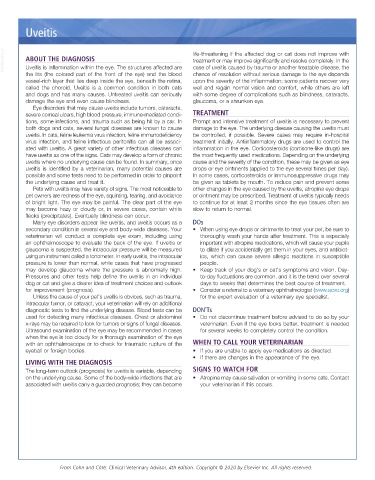Page 3143 - Cote clinical veterinary advisor dogs and cats 4th
P. 3143
Uveitis
VetBooks.ir ABOUT THE DIAGNOSIS life-threatening if the affected dog or cat does not improve with
treatment or may improve significantly and resolve completely. In the
case of uveitis caused by trauma or another treatable disease, the
Uveitis is inflammation within the eye. The structures affected are
the iris (the colored part of the front of the eye) and the blood chance of resolution without serious damage to the eye depends
vessel-rich layer that lies deep inside the eye, beneath the retina, upon the severity of the inflammation; some patients recover very
called the choroid. Uveitis is a common condition in both cats well and regain normal vision and comfort, while others are left
and dogs and has many causes. Untreated uveitis can seriously with some degree of complications such as blindness, cataracts,
damage the eye and even cause blindness. glaucoma, or a shrunken eye.
Eye disorders that may cause uveitis include tumors, cataracts,
severe corneal ulcers, high blood pressure, immune-mediated condi- TREATMENT
tions, some infections, and trauma such as being hit by a car. In Prompt and intensive treatment of uveitis is necessary to prevent
both dogs and cats, several fungal diseases are known to cause damage to the eye. The underlying disease causing the uveitis must
uveitis. In cats, feline leukemia virus infection, feline immunodeficiency be controlled, if possible. Severe cases may require in-hospital
virus infection, and feline infectious peritonitis can all be associ- treatment initially. Antiinflammatory drugs are used to control the
ated with uveitis. A great variety of other infectious diseases can inflammation in the eye. Corticosteroids (cortisone-like drugs) are
have uveitis as one of the signs. Cats may develop a form of chronic the most frequently used medications. Depending on the underlying
uveitis where no underlying cause can be found. In summary, once cause and the severity of the condition, these may be given as eye
uveitis is identified by a veterinarian, many potential causes are drops or eye ointments (applied to the eye several times per day).
possible and some tests need to be performed in order to pinpoint In some cases, corticosteroids or immunosuppressive drugs may
the underlying cause and treat it. be given as tablets by mouth. To reduce pain and prevent some
Pets with uveitis may have variety of signs. The most noticeable to other changes in the eye caused by the uveitis, atropine eye drops
pet owners are redness of the eye, squinting, tearing, and avoidance or ointment may be prescribed. Treatment of uveitis typically needs
of bright light. The eye may be painful. The clear part of the eye to continue for at least 2 months since the eye tissues often are
may become hazy or cloudy or, in severe cases, contain white slow to return to normal.
flecks (precipitates). Eventually blindness can occur.
Many eye disorders appear like uveitis, and uveitis occurs as a DOs
secondary condition in several eye and body-wide diseases. Your • When using eye drops or ointments to treat your pet, be sure to
veterinarian will conduct a complete eye exam, including using thoroughly wash your hands after treatment. This is especially
an ophthalmoscope to evaluate the back of the eye. If uveitis or important with atropine medications, which will cause your pupils
glaucoma is suspected, the intraocular pressure will be measured to dilate if you accidentally get them in your eyes, and antibiot-
using an instrument called a tonometer. In early uveitis, the intraocular ics, which can cause severe allergic reactions in susceptible
pressure is lower than normal, while cases that have progressed people.
may develop glaucoma where the pressure is abnormally high. • Keep track of your dog’s or cat’s symptoms and vision. Day-
Pressures and other tests help define the uveitis in an individual to-day fluctuations are common, and it is the trend over several
dog or cat and give a clearer idea of treatment choices and outlook days to weeks that determines the best course of treatment.
for improvement (prognosis). • Consider a referral to a veterinary ophthalmologist (www.acvo.org)
Unless the cause of your pet’s uveitis is obvious, such as trauma, for the expert evaluation of a veterinary eye specialist.
intraocular tumor, or cataract, your veterinarian will rely on additional
diagnostic tests to find the underlying disease. Blood tests can be DON’Ts
used for detecting many infectious diseases. Chest or abdominal • Do not discontinue treatment before advised to do so by your
x-rays may be required to look for tumors or signs of fungal diseases. veterinarian. Even if the eye looks better, treatment is needed
Ultrasound examination of the eye may be recommended in cases for several weeks to completely control the condition.
when the eye is too cloudy for a thorough examination of the eye
with an ophthalmoscope or to check for traumatic rupture of the WHEN TO CALL YOUR VETERINARIAN
eyeball or foreign bodies. • If you are unable to apply eye medications as directed.
• If there are changes in the appearance of the eye.
LIVING WITH THE DIAGNOSIS
The long-term outlook (prognosis) for uveitis is variable, depending SIGNS TO WATCH FOR
on the underlying cause. Some of the body-wide infections that are • Atropine may cause salivation or vomiting in some cats. Contact
associated with uveitis carry a guarded prognosis; they can become your veterinarian if this occurs.
From Cohn and Côté: Clinical Veterinary Advisor, 4th edition. Copyright © 2020 by Elsevier Inc. All rights reserved.

